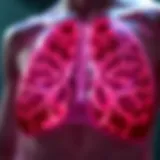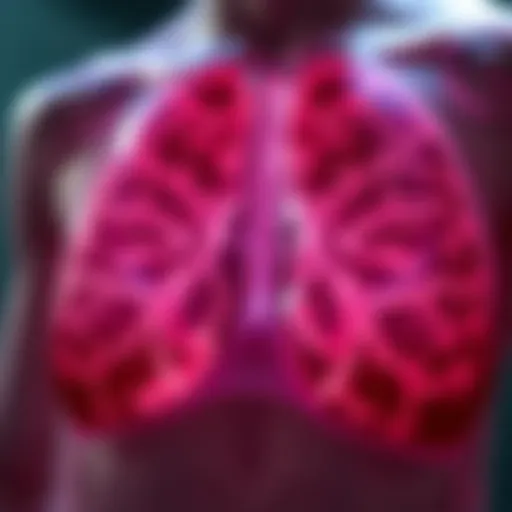Techniques and Outcomes in Hepatocellular Carcinoma Ablation
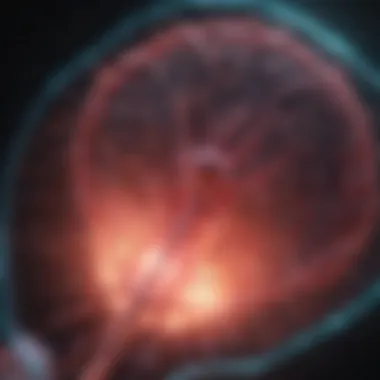

Intro
Hepatocellular carcinoma (HCC) stands as a formidable adversary in the realm of oncology, particularly given its connection to a multitude of chronic liver diseases. As the most prevalent type of primary liver cancer, HCC poses significant treatment challenges, calling for innovative approaches that balance efficacy and safety. Among such methods, ablation techniques have gained traction as promising alternatives, especially in the context of localized tumoral growths.
Ablation refers to a set of minimally invasive procedures aimed at destroying tumor cells while minimizing damage to adjacent healthy tissue. This capability is critical in hepatic scenarios where traditional surgical approaches may not be feasible due to the patient’s compromised liver function or the tumor's location. As we weave through the fabric of HCC ablation, we will explore the various modalities available, indications for use, as well as procedural specifics and the associated outcomes. The relevance of this topic extends not only to patients undergoing treatment but also to the wider healthcare community keen on expanding their understanding of evolving treatment fronts.
The following sections will delve deeper into the nuances of HCC ablation, addressing vital aspects such as patient selection criteria, potential complications, and where future research and innovations may be heading. This dialogue is not just for clinicians; it's for all stakeholders invested in the multifaceted world of liver cancer treatment.
Prologue to Hepatocellular Carcinoma
The discussion surrounding hepatocellular carcinoma (HCC) is of utmost importance, particularly given its rising prevalence as a critical issue in global health. Understanding the complexities of HCC sets the stage for exploring effective treatment methodologies, especially ablation techniques, which have garnered attention for their potential to offer targeted therapies while minimizing damage to the surrounding healthy liver tissues. This section will delve into essential elements that form the foundation of this article, focusing on the significance of recognizing the disease's nuances and nuances.
Definition and Epidemiology
Hepatocellular carcinoma is the most common form of liver cancer, stemming primarily from hepatocyte cells. The World Health Organization estimates that HCC accounts for approximately 75% of all primary liver cancers. The disease has a notably varied incidence rate across the globe, heavily influenced by underlying liver conditions such as hepatitis B and C virus infections and alcoholic liver disease. Countries in sub-Saharan Africa and East Asia report the highest HCC rates, potentially due to high rates of viral hepatitis. Understanding these demographics is crucial for creating comprehensive strategies to combat this disease and tailoring interventions to specific populations.
Risk Factors
Identifying risk factors associated with HCC helps in understanding the potential pathways for early diagnosis and prevention. A plethora of elements influence an individual’s likelihood of developing HCC, which include, but are not limited to:
- Chronic Viral Hepatitis: Infections, particularly hepatitis B and C, are leading culprits in the development of HCC.
- Cirrhosis: Patients with liver cirrhosis, regardless of the cause, carry a much higher risk of developing liver cancer.
- Alcohol Consumption: Heavy alcohol intake over prolonged periods can lead to liver damage, increasing cancer risk.
- Obesity and Type 2 Diabetes: Metabolic disorders are increasingly recognized as significant contributors to liver cancer.
- Exposure to Aflatoxins: These are naturally occurring toxic compounds that can contaminate food supplies in certain regions of the world.
By comprehensively assessing these risk factors, healthcare professionals can identify high-risk patients and implement preventative strategies more effectively.
Clinical Presentation
The clinical presentation of HCC is often insidious, complicating timely diagnosis. Early stages might not display any conspicuous symptoms, making regular screening essential for those at risk. However, when symptoms do appear, they can include:
- Weight Loss: Unexplained weight loss often raises eyebrows and warrants further investigation.
- Loss of Appetite: Patients may experience diminished hunger.
- Persistent Fatigue: A general feeling of tiredness may signal hidden health issues.
- Abdominal Pain: Discomfort, especially in the upper right abdomen, can be a telling sign.
- Jaundice: This yellowing of the skin indicates significant liver dysfunction.
In some cases, patients might present with advanced symptoms, where the cancer has progressed significantly, complicating treatment options further.
Understanding these signs is critical for healthcare practitioners. Early identification of HCC can greatly influence treatment efficacy and patient outcomes.
In summary, this introduction sets the stage for an in-depth exploration of HCC, laying the groundwork for appreciating the methods of ablation that follow. Recognizing the definitions, epidemiological patterns, risk factors, and clinical presentation enriches the reader's grasp of the subsequent sections discussing various treatment modalities and indications for intervention.
Overview of Treatment Modalities
When it comes to tackling hepatocellular carcinoma (HCC), understanding the array of treatment modalities is crucial. Different approaches must be carefully tailored to not just the characteristics of the tumor, but also the overall health of the patient, the functionality of their liver, and their life circumstances. Each modality comes with its unique set of benefits, drawbacks, and specific situational suitability that healthcare providers must consider.
This section serves as a roadmap through the treatment landscape, guiding professionals as they navigate the complexities of HCC management. A holistic comprehension of these modalities enhances decision-making and ensures that patients receive the most appropriate and effective care, ultimately improving chances for favorable outcomes.
Surgical Options
Surgical interventions hold a prominent place among the treatment options for hepatocellular carcinoma. Surgical resection involves removing the tumor and some of the surrounding liver tissue. The ideal candidates for this method typically have solitary tumors and are free of major underlying liver disease. However, it's important to remember that while surgical resection can offer a curative approach, it is not without its risks.
- Considerations: The liver's regenerative capabilities can support recovery after resection. However, extensive resections risk compromising liver function. It's a balancing act; surgeons must assess the size and location of the tumor against liver reserve.
- Benefits: For patients with early-stage HCC and preserved liver function, surgical options like resection or liver transplantation can significantly extend survival and even lead to cures.
Systemic Therapies
Systemic therapies, while different in approach, add a layer of treatment options for those who may not be suitable for curative surgical interventions. These therapies include chemotherapy, targeted therapies, and immunotherapy. In HCC, systemic approaches often serve as palliative care, but they can also serve a function in bridging to other treatments.
- Targeted Therapies: Such as sorafenib or lenvatinib, focus on specific molecular targets known to be involved in the growth and progression of cancer.
- Immunotherapy: Treatments like atezolizumab or nivolumab bring the body's immune system into play to fight cancer.
This category of treatment can be helpful for patients with advanced HCC or those presenting with multiple tumors, facilitating potential pathways to say goodbye to the nasty rogue cells without killing off healthy tissue in the process.
Local Therapies
Local therapies target the cancer directly, maximizing destruction while minimizing impact on healthy liver tissue. Techniques like radiofrequency ablation and microwave ablation fall under this umbrella, as does transarterial chemoembolization (TACE).
- Radiofrequency Ablation (RFA): This method employs heat to destroy cancer cells and works best when tumors are small and localized.
- Microwave Ablation (MWA): Similar to RFA but uses microwave energy; it can cover larger areas and expedite the ablation process.
Local therapies can offer a middle ground in treatment, allowing patients with inoperable tumors or compromised liver function to benefit from targeted interventions. Each method carries its technical nuances and considerations, which should be meticulously discussed with the patient.
In summary, the selection of treatment modalities remains pivotal in managing hepatocellular carcinoma effectively. By weighing the risks and benefits of surgical options, systemic therapies, and local therapies, healthcare professionals can tailor interventions to each patient’s unique clinical scenario, significantly impacting prognosis and quality of life.
Types of Ablation Techniques
Ablation techniques for hepatocellular carcinoma (HCC) hold a crucial spot in the ever-evolving array of treatment options available. The specificity and minimally invasive nature of these methods present a compelling alternative to more extensive surgical procedures, with the advantage of directly targeting tumor cells. Each technique, whether it be radiofrequency ablation, microwave ablation, cryoablation, or chemical ablation, provides unique benefits and considerations that inform care pathways for patients. Understanding these modalities enriches treatment choices and fosters more informed decision-making.
Radiofrequency Ablation (RFA)


Radiofrequency ablation uses heat generated by radio waves to destroy cancer cells. This method typically employs a needle electrode inserted into the tumor, allowing for localized thermal energy application. One of the key benefits of RFA is its ability to treat tumors up to three centimeters effectively, especially in patients who are not suitable for surgical intervention due to various health factors.
However, careful consideration regarding the tumor's location is necessary, as RFA can run the risk of harming adjacent structures if not executed precisely. Overall, RFA remains a cornerstone in the minimally invasive treatment of HCC, frequently discussed in academic literature due to its effectiveness and reduced recovery time compared to traditional surgical options.
Microwave Ablation (MWA)
Microwave ablation distinguishes itself from RFA mainly through the method of generating heat. Here, microwaves are utilized to promote rapid cell agitation, leading to higher temperatures and ultimately tumor necrosis. This technique offers several advantages over RFA, particularly when targeting larger tumors or lesions that are difficult to access. MWA can essentially treat larger surface areas more quickly, making it particularly suitable for tumors that resist other forms of treatment.
Nevertheless, caution is warranted as there may be collateral damage to adjacent tissues, requiring skillful execution and imaging guidance during the procedure. This approach has shown promising outcomes in studies, making it a contentious option among hepatocellular carcinoma specialists.
Cryoablation
On the opposite end of the temperature spectrum, cryoablation employs extreme cold to induce cellular death in tumors. This technique typically involves placing a probe in the tumor, which can lead to ice formation that destroys cancerous tissues. Cryoablation may appeal to oncologists due to its minimally invasive nature and low risk of bleeding. Its application tends to be more favorable in tumors that are challenging to treat with heat-based methods.
Yet, the specificity of cryoablation calls for more detailed imaging studies to guide the placement of the probe accurately. It’s crucial to comprehend that while cryoablation may afford a lower hospitalization time, some patients report discomfort due to the thawing of tissues post-procedure. Overall, the choice of this technique is carefully weighed against patient health status and tumor characteristics.
Chemical Ablation
Chemical ablation utilizes substances like ethanol or acetic acid injected directly into the tumor to induce necrosis. This approach is often utilized when tumors are small and located in areas poorly accessed by more invasive methods. One of the primary advantages of chemical ablation is its cost-effectiveness and simplicity. It’s especially beneficial in patients with significant comorbid conditions who may not withstand more extensive procedures.
However, the effectiveness of chemical ablation can vary significantly based on the tumor’s size and location. Thus, thorough pre-procedural assessments are critical to selecting the best candidates for this treatment option. As efficacy slightly lags behind other techniques, it may be reserved for specific cases rather than a go-to method for HCC treatment.
In summary, each ablation technique presents its own set of benefits and limitations. Evaluating these methods within the specific context of a patient’s condition is imperative for treatment success. The ongoing advancements in these techniques and related imaging technology continue to refine how oncologists navigate care pathways for hepatocellular carcinoma.
Indications for Hepatocellular Carcinoma Ablation
Ablation techniques for hepatocellular carcinoma (HCC) play a pivotal role in managing this complex disease. Understanding the indications for these procedures equips healthcare providers to make informed decisions that could significantly affect patient outcomes. The criteria for ablation are not just a set of strict measurements; they involve nuanced considerations that balance tumor characteristics, the overall health of the patient, and liver function. This intersection of factors underscores the necessity of a comprehensive evaluation process, ensuring optimal treatment paths can be directed toward those who will benefit the most.
Tumor Size and Number
One of the first aspects to consider is the size and number of tumors present in the liver. Guidelines often designate specific criteria for size; most commonly, tumors measuring less than three centimeters are considered more amenable to ablation techniques. When discussing multiple lesions, the threshold also shifts. For instance, a solitary tumor often yields better prognosis indicators compared to a scenario where multiple small tumors exist. Therefore, a single tumor of medium size might be a suitable candidate for radiofrequency ablation, while a singular tumor of greater diameter may steer clinicians toward considering other treatments.
- Single Tumor: Typically better for ablation if under 3cm.
- Multiple Tumors: Might complicate eligibility; often requires assessing overall liver condition.
The ideal ablation candidate typically features a solitary tumor, preferably less than three centimeters in diameter, offering the potential for optimal ablation outcomes.
Liver Function Considerations
Another crucial factor underlining the indications for ablation focuses on liver function. Prior to considering ablation, a full evaluation of the liver’s health is imperative. Instruments like the Child-Pugh score are invaluable in this aspect, helping healthcare providers gauge the liver's capabilities. Patients classified under Child-Pugh class A often demonstrate better outcomes post-ablation. Contrarily, those in Class B or C might face increased risks of complications. Adequate liver function not only influences recovery but also informs subsequent treatment choices.
- Child-Pugh Class A: Generally suitable for ablation.
- Child-Pugh Class B or C: Higher complication risks may necessitate alternative approaches.
Patient Health Status
Lastly, we must not overlook a patient’s overall health status when evaluating indications for HCC ablation. Factors such as comorbidities, age, and functional status can drastically alter suitability for different ablative techniques. For instance, a younger patient with multiple health challenges might still be an appropriate candidate for ablation, while an elderly individual with significant comorbidities may warrant a more cautious approach. This underscores the importance of individualized treatment planning, taking into account not just the cancer itself but how the patient’s overall health landscape may interact with treatment outcomes.
- Younger, Healthier Patient: Likely to tolerate ablation better.
- Older Patient with Comorbidities: May face dilemmas regarding treatment risks versus benefits.
In summary, understanding these indications isn't merely about categorizing tumors; it's about taking a holistic approach to each patient's unique situation. The interplay of tumor characteristics, liver function, and the patient’s overall health guides clinicians towards the most effective decisions in the ablation landscape.
Pre-procedural Assessments
Pre-procedural assessments stand as a cornerstone in the roadmap of hepatocellular carcinoma (HCC) ablation. The main aim of these evaluations is to set up a solid foundation for both safety and efficacy of the procedure. They are not just a checklist to tick off; they weave a narrative of understanding the patient's unique condition, which ultimately shapes the outcomes of the treatment.
Imaging Studies
Imaging studies play a critical role throughout the pre-procedure stage. Using advanced techniques like ultrasound, CT scans, and MRI, healthcare professionals gain a comprehensive view of liver anatomy and tumor characteristics. These images hold vital details; they can help in determining tumor size, location, and the presence of surrounding liver pathology.
- Ultrasound is often the first port of call due to its accessibility and cost-efficiency. It allows for real-time assessment and can guide the physician during minimally invasive procedures.
- CT Scans provide a more detailed cross-sectional view of the liver. This imaging can unmask hidden lesions and give a clearer picture of vascular involvement.
- MRI is frequently used when there is a need for enhanced contrast resolution to discriminate between benign and malignant lesions.
The findings from these tests inform the selection of ablation technique, as certain methods might be more suitable depending on the size and location of the tumor. Essentially, these studies help craft a personalized approach to treatment, reducing the likelihood of unforeseen complications.
Laboratory Tests
Laboratory tests also contribute remarkably to pre-procedural assessments. These tests are not only about assessing liver function, but they act as barometers for the patient’s overall health and capability to withstand the procedure. Biochemical markers such as ALT, AST, and bilirubin levels provide crucial insights into liver function, indicating how well the organ is functioning.
- Liver Function Tests: These assess how well the liver is handling its responsibilities. Elevated liver enzymes can signal underlying issues that might complicate ablation.
- Coagulation Profile: It's important to understand the clotting status; patients with poor coagulation might be at an increased risk of bleeding during or after the procedure.
- Alpha-fetoprotein (AFP): This tumor marker can be a boon in tracking the tumor response post-ablation and may influence decision-making if levels are significantly elevated.
Pre-procedural assessments, when executed thoroughly, not only ensure the right procedure is performed but also bring to light potential pitfalls. It’s like laying a well-planned map before embarking on a journey. By paying close attention to these details, healthcare providers can smooth out the bumps in the road ahead for their patients.
The Ablation Procedure
The process of ablation in hepatocellular carcinoma (HCC) is a pivotal part of treatment strategies. The main objective here is to specifically target and eradicate malignant cells while maintaining the integrity of the surrounding liver tissue. As HCC can often be difficult to manage, especially in patients with underlying liver disease, understanding the nuances of the ablation procedure is critical for achieving favorable outcomes. This section will delve into two essential aspects: the preparation stages involving anesthesia and patient positioning, along with the execution of the techniques themselves.
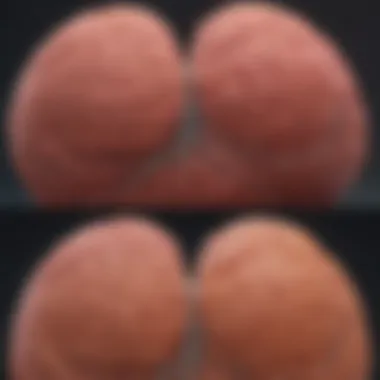

Anesthesia and Positioning
The choice of anesthesia during the ablation procedure is not merely a matter of comfort; it plays a significant role in the safety and efficacy of the intervention. Usually, moderate sedation or general anesthesia is considered based on the patient's health status and the complexity of the procedure. For instance, patients who may not tolerate prolonged procedures well might benefit from deeper sedation.
Positioning is equally crucial; the goal is to provide both optimal exposure for the operator and minimal discomfort for the patient. Generally, patients are positioned supine with the right arm raised, allowing better access to the liver, especially during percutaneous approaches. Understanding and implementing correct positioning can lessen the chances of procedure complications and enhance the accuracy of targeting the tumor.
Technique Execution
Executing the ablation technique involves multiple steps, and precision is of the essence. First off, imaging studies, such as ultrasound or CT scans, are essential for guiding the procedure. They help to locate the tumor accurately and confirm its size and vascular involvement. As an operator, relying on these imaging modalities enhances the likelihood of successful ablation.
The following steps outline the execution of the procedure:
- Preparation: The site of intervention is carefully cleaned and draped to maintain sterility.
- Local Anesthesia: For procedures done under moderate sedation, localized anesthesia may be administered to reduce pain at the site of needle insertion.
- Needle Insertion: A thin probe, specific to the chosen technique—be it radiofrequency or cryoablation—is dermally inserted while constantly monitoring through imaging.
- Energy Delivery: Depending on the technique, energy is either applied via heat (radiofrequency, microwave) or cold (cryoablation) to destroy the target tumor cells.
- Monitoring: Continuous monitoring is necessary to watch for any immediate complications or reactions.
It is essential for practitioners to stay updated with the latest protocols and techniques, as advancements in technology are consistently enhancing procedural efficacy.
By focusing on the meticulous execution of the ablation procedure, healthcare providers can yield heightened success rates and minimize adverse effects often associated with liver surgeries.
Understanding these intricate processes allows medical professionals to make informed decisions, ultimately tailoring interventions to the unique needs of patients suffering from this challenging ailment.
Post-procedural Considerations
In the journey of managing hepatocellular carcinoma (HCC), post-procedural considerations play a pivotal role in the overall treatment outcome. After ablation techniques have been executed to target tumor cells, the immediate and subsequent follow-ups form the backbone of patient care. These considerations not only ensure the effectiveness of the procedure but also prioritize patient safety and well-being.
The majority of patients recovering from ablation require careful monitoring to ascertain that the targeted tumors have been effectively destroyed and to check for any emerging complications. The approach taken during this period often varies, but the fundamental goal remains the same: to maximize patient outcomes while minimizing risks.
Monitoring and Follow-up
Monitoring after an ablation procedure is crucial. This phase commonly involves several key components:
- Imaging Studies: Most practitioners will recommend follow-up imaging studies, often through ultrasound or CT scans, to visualize the liver and the treated area. These imaging tests can determine if the tumors are still present or if there has been any regrowth.
- Clinical Assessments: Routine clinical evaluations are essential. Physicians will typically assess the patient’s overall health, including liver function tests, to ensure that the liver is recovering well from the procedure.
- Patient Reports: Communication with the patient is fundamental. Reports regarding any unusual symptoms or side effects should not be taken lightly, as they can indicate potential complications that need addressing.
Patients undergoing ablation often find solace in structured follow-up schedules. Such protocols not only help in early detection of issues but also foster a sense of security among patients, ensuring them that they are actively involved in their recovery journey.
Potential Complications
Unexpected complications can arise after any medical procedure, and ablation is no different. Being aware of these potential hurdles is essential. Here are some complications that might occur:
- Post-Ablation Syndrome: Commonly characterized by abdominal pain and fever, this syndrome can manifest days after the procedure. It typically resolves on its own but may require symptomatic management.
- Hemorrhage: Though rare, internal bleeding in the liver area or surrounding tissues can happen. This scenario usually necessitates close monitoring or further intervention.
- Infection: Any invasive procedure can increase the risk of infections. Symptoms to watch out for include redness, swelling, or drainage from the site, along with general fever.
- Bile Duct Injury: Ablation can lead to bile duct injuries, affecting bile flow and leading to jaundice or other liver-related issues.
Understanding these potential complications can empower patients and caregivers, enabling them to recognize symptoms early and take action.
Post-procedural considerations encompass both diligence and a patient-centric approach to recovery. By integrating careful monitoring and being alert to potential complications, healthcare providers can significantly shape the trajectory of patient outcomes in the context of hepatocellular carcinoma ablation.
"In health care, as in life, it is not merely the success of the intervention that matters, but how one navigates the aftermath that truly counts."
Ultimately, a cohesive plan that addresses these elements will help to ensure that patients receiving ablation for HCC can reclaim their health and quality of life as swiftly as possible.
Efficacy of Hepatocellular Carcinoma Ablation
The efficacy of ablation techniques for hepatocellular carcinoma (HCC) is a pivotal aspect of this discussion. It ties together elements of treatment success and patient quality of life, making it a crucial focus in understanding how these approaches impact patient outcomes. Evaluating the effectiveness of these techniques involves looking into metrics such as survival rates, recurrence rates, and overall impact on the patient's well-being.
Survival Rates
Survival rates serve as a critical measure in determining the success of hepatocellular carcinoma ablation. Various studies indicate that these techniques can significantly improve the prognosis for patients diagnosed with early-stage HCC. For instance, when comparing various ablation techniques:
- Radiofrequency ablation (RFA) often shows a 5-year survival rate of about 70-90% for patients with tumors smaller than 3 cm.
- Microwave ablation (MWA) may yield similar results but can be more effective in slightly larger tumors.
The influence of liver function is another consideration, as the Child-Pugh score is often used to stratify risk and predict survival outcomes. Patients with Child-Pugh A scores generally have better survival outcomes following ablation, compared to those with class B or C. Ultimately, survival rates depend on multiple factors, including:
- Tumor size and location
- Presence of underlying liver disease
- Range of the ablation technique used
"The importance of early detection and personalized treatment plans cannot be understated in enhancing survival outcomes for HCC patients."
Recurrence Rates
Alongside survival rates, examining recurrence rates is essential to understanding the durability of HCC ablation. Recurrence of HCC post-ablation can occur due to several factors, including incomplete tumor destruction during the procedure, aggressive tumor biology, or the presence of residual liver disease. Recurrence rates can vary, but some common observations include:
- RFA shows a recurrence rate ranging from 20% to 50% within five years.
- MWA has the potential to lower recurrence rates due to its ability to treat larger tumors effectively.
It is also worth noting that the intervals for follow-up imaging play a vital role in early detection of any recurrence, allowing timely intervention. Monitoring patients regularly with imaging techniques such as ultrasound or CT scans can significantly improve management strategies.
By recognizing these rates and their implications, healthcare providers can make informed decisions regarding the management of hepatocellular carcinoma, ultimately aiming to enhance patient outcomes while minimizing the risk of recurrence.
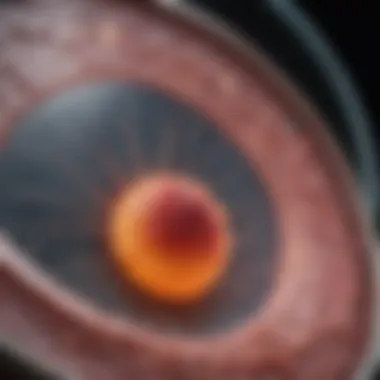

Comparative Analysis of Ablation Techniques
The discussion of comparative ablation techniques is vital, particularly in the context of hepatocellular carcinoma treatment. It's crucial for healthcare providers and patients alike to understand the various approaches, as the effectiveness can greatly influence treatment decisions and patient outcomes. Comparing these techniques often reveals not only their specific advantages but also potential drawbacks, which can affect individual patient scenarios.
RFA vs. MWA
Radiofrequency Ablation (RFA) and Microwave Ablation (MWA) are two prominent modalities used for treating hepatocellular carcinoma. Their fundamental goal is to destroy tumor cells effectively, but they operate through different mechanisms and come with distinct profiles in terms of effectiveness, procedural methodology, and patient outcomes.
- Mechanism of Action: RFA employs an alternating current that generates heat, which then targets tumor cells to induce cell death. In contrast, MWA uses electromagnetic waves to produce heat through molecular agitation. This allows MWA to often achieve faster ablation times, which can be beneficial in certain clinical scenarios.
- Efficacy and Treatment Speed: Studies have shown that MWA generally allows for larger ablation zones compared to RFA. This characteristic can shorten surgical duration significantly and might lead to better overall outcomes for sizeable tumors. But RFA has shown excellent results with smaller tumors, with some reports indicating superior local control in lesions less than 3 cm.
- Accessibility and Suitability: RFA can sometimes be more easily integrated into outpatient settings, while MWA might require more specific equipment and expertise. Thus, not all treatment facilities will have access to microwave technology, which can limit patient choices.
In summary, RFA remains a gold standard for small tumors, while MWA is gaining recognition for its speed and potential efficacy with larger lesions. Decisions regarding RFA versus MWA should be made based on a myriad of factors including tumor size, location, available technology, and patient health status.
Cryoablation vs. Chemical Ablation
Cryoablation and Chemical Ablation present another contrast within the realm of localized treatment for hepatocellular carcinoma. Both are intended to destroy tumor cells, albeit through disparate methodologies.
- Mechanism of Action: Cryoablation employs extreme cold to freeze tissue, disrupting cellular integrity and leading to cell death. Conversely, Chemical Ablation involves direct injection of chemical agents like ethanol or acetic acid into the tumor to induce necrosis through chemical destruction.
- Indications and Application: Cryoablation is often favored for tumors in difficult anatomical regions due to its precision. As for chemical ablation, ethanol injections are widely utilized for tumors that are hard to reach or when there is a risk of complications with thermal methods.
- Recovery and Complications: One distinct aspect of these two techniques is how patients recover. Cryoablation may have more extensive post-procedural management needs due to freezing effects, which can lead to more significant discomfort initially. Chemical ablation, however, can sometimes lead to immediate complications like bleeding and infection but tends to be less invasive overall.
In the battle of Cryoablation versus Chemical Ablation, each technique has contexts where it shines. The decision largely revolves around individual patient characteristics, tumor specifics, and the experience of the medical team performing the procedures.
A thorough understanding of each technique ensures that the best possible treatment can be selected, ultimately aiming for more favorable outcomes and improved therapeutic trajectories.
Patient Quality of Life
The conversation surrounding hepatocellular carcinoma (HCC) ablation often centers on the survival rates and technical efficacy, but what truly holds significance for patients is the quality of life post-treatment. Understanding patient quality of life helps stakeholders better assess both the immediate and long-term outcomes of various therapeutic strategies. Considerations surrounding quality of life encompass physical, emotional, and social domains that treatment outcomes inevitably influence, making it a multifaceted yet crucial metric in the assessment of HCC management.
Treatment Impact on Daily Life
The impact of HCC ablation on daily life can be profound. After undergoing procedures such as Radiofrequency Ablation (RFA) or Microwave Ablation (MWA), many patients report experiencing significant changes in their routines and capabilities. Here are some important elements to consider:
- Physical Well-being: Patients often experience pain or discomfort immediately after treatment. However, many also find that symptoms of liver dysfunction, such as fatigue or discomfort, improve remarkably after successful ablation.
- Ability to Perform Daily Tasks: A successful ablation can lead to a regained independence. Patients generally find they can resume chores, hobbies, and even professional commitments that were significantly impaired due to the condition.
- Nutritional Changes: Post-treatment lifestyle adjustments may prompt changes in diet. A healthier eating plan can become a focus, promoting better liver health and improved overall well-being.
Despite generally positive reports, it's essential to recognize the variability in experiences. Not all individuals will have the same recovery trajectory, and factors such as age, initial health status, and the extent of liver disease play a role.
Psychosocial Aspects
Emotional and social components of recovery cannot be overlooked. Psychosocial aspects are as crucial as physical health in determining a patient's quality of life. Recognizing and addressing these concerns can lead to better outcomes:
- Emotional Well-being: Patients may struggle with anxiety or depression, stemming from their diagnosis or the uncertainty of treatment outcomes. Addressing these feelings proactively through counseling or support groups can significantly contribute to mental health resilience.
- Social Interaction: Support from family and friends is invaluable. Treatment, especially when coupled with the fear of mortality, can lead to isolation. Encouraging social engagement can alleviate some of these burdens.
- Lifestyle Modifications: Psychological impact can also manifest in the form of lifestyle changes. Patients may feel compelled to focus more on wellness practices, leading to a more balanced life. Activities like gentle exercise, meditation, or joining community health programs may emerge from this.
The integration of emotional care into the treatment plan for HCC can drastically improve overall quality of life.
Future Directions in HCC Ablation
The field of hepatocellular carcinoma (HCC) ablation is on the brink of significant transformation, driven by technological advancements and the ongoing search for enhanced treatment efficacy. As we delve into this subject, it becomes clear that understanding future directions is crucial. For practitioners, awareness of emerging techniques can shape treatment protocols, while researchers can capitalize on these insights to explore new avenues of investigation. Here’s a closer look at the anticipated developments.
Technological Innovations
Innovations in technology are paving the path for more effective HCC ablation techniques. One prominent advancement is the integration of image-guided systems. With high-resolution imaging modalities like MRI and ultra-sound, practitioners can now visualize tumors with greater precision before and during ablation procedures. This aids in accurate targeting, potentially increasing the effectiveness of treatments.
- Robotic Tools
Robotic-assisted systems are also gaining traction. They enhance the surgeon's dexterity and control, allowing for minimally invasive approaches that can be less taxing on patients. The use of robotic arms enables finer movements and real-time adjustments, reducing the risk associated with traditional methods. - Biomaterials and Ablation Devices
New biomaterials are being developed to improve the efficacy of thermal ablation devices. Materials that maintain higher temperatures for longer periods can be utilized, ensuring a thorough destruction of the tumor while minimizing the damage to surrounding tissues. Additionally, devices that operate at differing frequencies may provide tailored treatment options based on tumor characteristics.
Adapting treatment protocols according to the advancements in technology holds a promise for better outcomes. With continued research, there is a potential for unique combinations that offer even greater improvements in patient prognosis.
Combination Therapies
As the understanding of HCC continues to evolve, the role of combination therapies is increasingly recognized. These protocols merge different modalities, such as combining ablation with systemic therapies. The rationale behind this is fairly straightforward – two heads are often better than one.
- Ablation with Systemic Agents
Using systemic therapies like targeted medications alongside ablation can suppress any residual tumor cells after the primary ablation. For instance, combining a drug such as sorafenib with an ablation technique may inhibit the tumor microenvironment, reducing the likelihood of recurrence. - Improved Patient Selection
The study of biomarkers could enable the selection of patients who are most likely to benefit from these combination approaches. Investigating genetic and proteomic profiles will help tailor treatments that suit individual patient needs.
The implications of these therapies are vast, offering a multi-faceted approach to combat the persistence of hepatocellular carcinoma. In doing so, healthcare professionals can provide more personalized treatment plans, potentially improving the overall quality of life for patients.
In summary, the future of HCC ablation is promising. With technological innovations at the forefront and combination therapies gaining momentum, the upcoming years could mark a decisive shift in the management of this challenging malignancy, leading to more optimized treatment pathways and enhanced patient outcomes.
Closure
The conclusion serves as a pivotal point to wrap up the multifaceted discussion surrounding the ablation of hepatocellular carcinoma (HCC). It not only summarizes the findings of the previous sections but also elucidates the significance of these insights in clinical practice and ongoing research.
Summary of Key Points
In the exploration of HCC ablation, several key points emerge:
- Efficacy of Techniques: Various ablation modalities, including radiofrequency and microwave ablation, have shown promising results in tumor control. Each technique has its unique advantages, paving the way for tailored treatment plans based on individual patient profiles.
- Indications and Considerations: The appropriateness of ablation depends on tumor characteristics such as size, number, and liver function status. Understanding these parameters is essential in selecting suitable candidates for this treatment.
- Outcomes and Follow-Up: Data on survival and recurrence rates following ablation highlight its effectiveness, yet underscore the necessity for diligent post-procedural follow-up and monitoring. This vigilance is critical to manage and mitigate potential complications that may arise.
- Future Directions: Emerging technologies and possible combination therapies represent an exciting frontier in HCC management, offering hope for better outcomes and enhanced patient quality of life.
Implications for Practice and Research
As healthcare professionals grapple with rising HCC cases globally, the insights gleaned from this article carry profound implications:
- Clinical Practice: The information presented can guide clinicians in making informed decisions about the implementation of ablation techniques. This knowledge base is vital for fostering an individualized approach to treatment, ensuring the best possible outcomes for patients.
- Research Opportunities: There remain numerous areas ripe for investigation, especially concerning the long-term effects of various ablation techniques and the exploration of new modalities. Professionals are encouraged to engage in studies that further elucidate these complexities.
- Holistic Care: Recognizing the psychosocial aspects of patient care is crucial. Integrating mental well-being into the treatment framework can lead to better compliance and satisfaction, ultimately improving overall treatment success rates.


